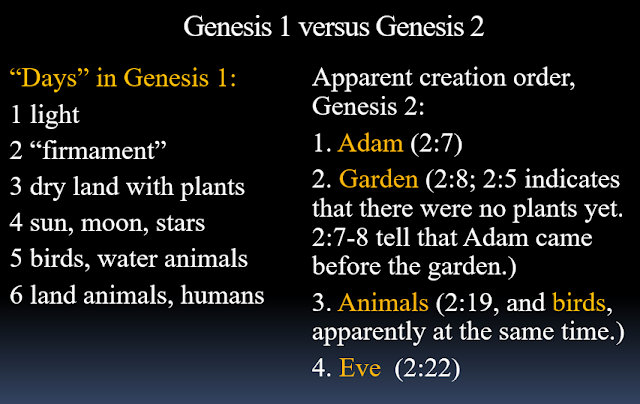An article published by Answers in Genesis complains about illustrations of the animals on Noah's Ark, often found in children's books, and elsewhere. (It complains about other things, but I'll try to stick to a discussion of what the animals on the ark looked like.)
Here is a quotation from the article:
Zebras, Clydesdales, and donkeys are all part of the horse kind and came to look like they do today since the Flood as part of the one horse kind. Species and the biblical kind are not necessarily the same things. The original horse kind likely had features resembling each of these. They diversified into what we have today through natural selection in the wild and artificial selection for man’s benefit. The same is true with the cat kind. Domestic cats, lions, bobcats, tigers, and so on, are all varieties in the one cat kind that have developed through variation since the Flood. It is better to draw generic representatives of each kind ...
Let's re-state that section of the article. The author, speaking for Answers in Genesis (AiG), claims that the animals on the Ark did not look a lot like the animals of today. Why is that claim made? The main reasons are that AiG believes that there was a world-wide flood, about 2348 BC, and that all land animals descended from creatures that were rescued on the Ark. AiG also believes that there would not have been room for each species of animal (and food needed to keep them alive) on that vessel, so that there were, instead, founders of each kind, which, since the Flood, diversified rapidly into the multitude of species that live on earth now. (Apparently this sort of belief has not been around for very long in AiG circles, but it is strongly held now.) In other words, the quotation says, there were no tigers or lions, etc., on the Ark, just a pair of cat family ancestors - generic representatives. So how did approximately 40 living species of cats come about? (And some additional extinct ones -- AiG belief is that extinct animals became extinct after the Flood.) AiG's answer is that there was rapid evolution (although they seldom use that word) after the Flood, and that all of these, living and extinct, are descendants of the pair of cat ancestors that were on the Ark. AiG thinks that distinguishing features didn't arise until after the animals came off of the ark -- the cat ancestors probably didn't have stripes, a mane, spots, cheetah-like speed, the ability to climb trees, and other features now found in one or a few species of the cat family, but not the entire family.
Another AiG source says this: "Recent studies estimate the total number of living and extinct kinds of land animals and flying creatures to be about 1,500. With our “worst-case” scenario approach to calculating the number of animals on the Ark, this would mean that Noah cared for approximately 7,000 animals." [pairs or sevens of each kind]
That seems like a lot, but according to my calculations, there are over 31,000 species of animals alive on earth today, to say nothing of extinct ones. That would mean that each of the kinds on the Ark would, on average, have diversified into about 20 species each, all within less than 4600 years.
That's preposterous, of course. Such rapid and extensive speciation, in vertebrates, has not been observed. Biologists generally believe that new species can't develop unless isolated from others in the same line in some way, either by being geographically separated, by mating at different times, or other behavioral differences, or by hybrid sterility. Cave art does not seem to indicate that early humans saw animals that were substantially different than those we see today. Although the Bible does not describe vertebrate animals in any detail, the behavior described (lions as predators, for example) does not suggest that lions, in Bible times, were much, if any, different from those that live today. Samson and David had interactions with lions. Jacob's blessing on his son Judah includes this: Genesis 49:9 "Judah is a lion’s cub. From the prey, my son, you have gone up. He stooped down, he crouched as a lion, as a lioness. Who will rouse him up?" Jacob died in about 2000 BC. Samson lived at about 100 years before David, who lived at about 1000 BC. (For my post, indicating all the mentions of lions in the Bible, see here.) As I indicated, the Bible does not describe animals definitively, but it sounds like, by the time of Jacob, as well as Samson and David, lions were like those alive today. If they hyperevolved somehow, from an ancestral cat type, this would have happened in less than 400 years, using AiG's timeline.
It seems to me that it makes a lot more sense to suppose that the Flood was not world-wide, and that cats, and other animals, diverged over a much longer period of time.
For an expanded discussion of these ideas, see my post here.
It seems to me that it's OK to put lions, tigers, bears, donkeys, giraffes, etc., in illustrations of Noah's Ark. We don't really know if there was a world-wide Flood, and the proposal that children's Bible story art be based on unproven, even false, ideas is dangerous.
Sidelight 1: By the time of Zechariah, about 500 BC, horses, mules and donkeys must have diverged, although, even today, they haven't completely diverged, as mules are the offspring of a donkey-horse mating. According to AiG, that divergence took place after the ark. According to all sorts of other evidence, it took place over a much longer time.
Zechariah 14:15 "So will be the plague of the horse, of the mule, of the camel, and of the donkey, and of all the animals that will be in those camps, as that plague." The Masoretic Text uses three different names for the members of the horse family named in this verse, indicating that there were three different animals, all horse-like. (The King James uses "ass" instead of donkey.) The use of these words goes back way before Zachariah -- for example, Pharaoh's army included horse-drawn chariots.
Sidelight 2: The author of the quotation at the beginning of this post, and AiG, should be commended for at least one thing. The author says that artists often portray Adam and Eve as white, or white, blue-eyed blondes, and states that this is most likely not the way that they really looked.
Thanks for reading.
*Added November 6, 2023: The article from AiG also includes this complaint (and over a dozen others): "Not including dinosaurs and pterodactyls (e.g., dragons) on the Ark"





